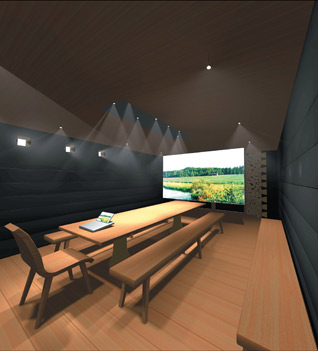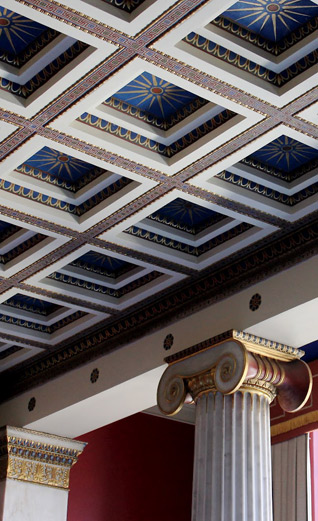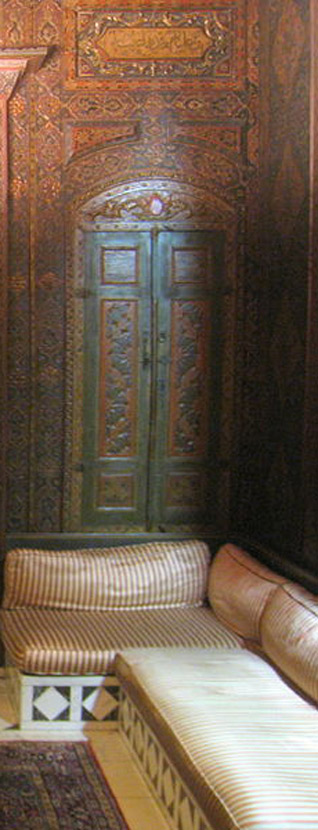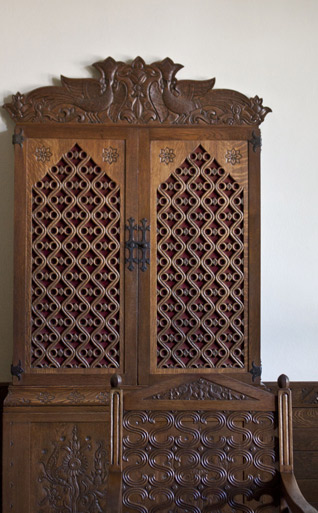
Above: the Finnish classrom. Below, first from bottom: the blackboard and professor's chair in the Italian classroom. Second from bottom - a corner-view of the Syrian/Lebanese classroom. Third from bottom: Ceiling & columns in the Greek classroom.



Travel
Cathedral of Learning
T. SHER SINGH
DAILY FIX
Friday, June 22, 2012
One of the most poignant celebrations of today’s multicultural reality I have seen anywhere sits in the heart of Pittsburgh, Pennsylvania, U.S.A.
The University of Pittsburgh takes great pride in its 42-storeyed “schoolhouse” - a huge Gothic wonder placed right in the centre of the campus.
It’s been dubbed the Cathedral of Learning.
However, what makes this building unique in the world is what it boasts on two of its floors.
They were - at last count - 29 unusual classrooms, popularly known as the Nationality Rooms, and enjoy pride of place on the first and third floors.
Each room is inspired by the culture and traditions of a different nation; collectively, they represent the various immigrants who came to the Pittsburgh area, made it their home and helped build it into one of the most vibrant and productive areas in the world.
“In their diversity, the rooms preserve and honour our ethnic identities,” explains the President of the University. “Collectively, they symbolize our national unity.”
It was the brain-child of John Bowman, the University Chancellor in 1926, who began the construction of the Cathedral. He challenged the various “ethnic” communities of the area to help create these classrooms by invoking the most creative periods and aspects of their respective heritages.
Not only did ordinary, working-class men and women join in this labour of love, but so did school children and corporations. It very quickly proved a magnet for the support of members of the communities across the nation and, ultimately, all the way back to their respective motherlands.
Each community helped set up a committee and took on the responsibility of financing and designing one classroom. The University retained overall supervision to ensure a commonality of vision.
It took 12 years to finish the first lot: the German, Russian, Scottish, Swedish, and American classrooms. The following year brought the Chinese, Czechoslovak, Hungarian, and Yugoslav rooms. They were followed by the Greek, Syrian/Lebanon, Lithuanian, Polish, French, and Romanian classrooms.
The first post-war decade saw the completion of the Norwegian, Italian, English, and Irish classrooms. After a further lapse of 30 years, four more: Israel, Armenian, African, and Ukrainian.
A few more were in the offing when I visited them last.
The actual classrooms are a pleasure beyond description. Each is a masterpiece which has captured a bit of the heart and soul of each culture. Designed, formulated, inspired, constructed and paid for by members of the respective communities - often by artists and artisans brought in from former homelands - each is a loving depiction of a culture.
Each room is a museum … yet, used from early morning till late every weekday evening as a fully functioning classroom!
Let me give you a taste.
The Italian classroom. A 15th century Tuscan monastery theme. The black-board hides behind a cabinet traditionally used for a priest’s vestments. A turquoise cazetta ceiling. Red-tile floor patterned after Florence’s Palazzo Vecchio. Florentine fireplace. Savonarola chairs. Monastery choir benches. Latin inscriptions in lettering borrowed from the Arch of Titus in Rome. Shuttered windows. A bronze bust of Dante. A mural commemorating the 1678 granting of the first university degree to a woman, in Padua.
The Israel classroom. A First century Galilean stone-dwelling. Stone benches from a 2nd-3rd century synagogue of Capernaum. Moses’ Commandments carved in Hebrew on the doors. Plaster inscription of Talmudic rules on growing crops. A replication of a Dead Sea Isaiah Scroll segment. The professor’s desk? A stone-table from first century Jerusalem. Sixth century murals from the Dura Europos synagogue hide the blackboard. The floor? A mosaic duplicating one from the 6th century Galilean synagogue of Beth Alpha.
Sitting there, in each of those classrooms, one can feel the lotus petals of the mind open. A gentle, gnawing hunger is suddenly felt deep inside … to know more. I looked at the faces around me: each visitor, like me, was silent, solemn, respectful, thoughtful. But we betrayed one common flicker in our eyes: we wanted to be back in school. This school.
Walking from one room to another, one quickly realizes that they represent, in their collective presence, one of the very few bits of evidence that we are indeed civilized, in the highest sense of the word.
It is a success story par excellence. It records. It recognizes. It honours, it respects, it inspires, it celebrates, it sings, it draws out and builds on the strengths of all. And yet, it steps on no toes. Everybody gains from it.
It is a worthy model, and its spirit is worth emulating. Not just in every University, but in every institution and organization, every project and venture, in every land. Not necessarily by constructing Nationality Rooms in every building, but by being open thus to ideas and influences from any direction that has merit and relevance.
Every visit to this hallowed place inspires me like very few things do. So, I go back every few years, even if it means making a wide detour while heading for another destination.
I know that American families habitually make annual pilgrimages to national sites: Washington, D.C., Niagara, Grand Canyon, Liberty Bell, Yosemite, Gettysburg, Yellowstone …
I would put this one right on top of the list, if I was you.
Even if you aren’t American.
Conversation about this article
1: Chintan Singh (San Jose, California, U.S.A.), June 22, 2012, 11:11 AM.
Any chance there could be a Sikh classroom in there? I know we are not a nation, but we are an ethnic minority and do have a sizeable community in the Pittsburg Metropolitan area.
2: Jaskiran Kaur (New Jersey, U.S.A.), June 22, 2012, 1:05 PM.
There are countless Sikhs with oodles of money in the Pittsburgh area. But, of those I know, their favourite way of passing time is watching Bollywood movies and drinking. I checked with a couple this morning. They've lived in the vicinity for ever, but have never heard of the Nationality Rooms, never been there! But there's no reason why, with the proper commitment, we can't do our own classroom. The Indians have done it, and it is the cheapest one of the whole lot - typical stuff that desis do wherever they go. They'll fight our desire to have our own Sikh classroom tooth and nail, but when has mischief ever won? We can do it if we want to. But someone has to start! Sadly, groups such as "world" councils and organizations have neither the brains nor the commitment to do something like this ... that is, something useful. So, it'll have to be some enlightened individuals who have to get it going, if we are to do it. Anyone game?


